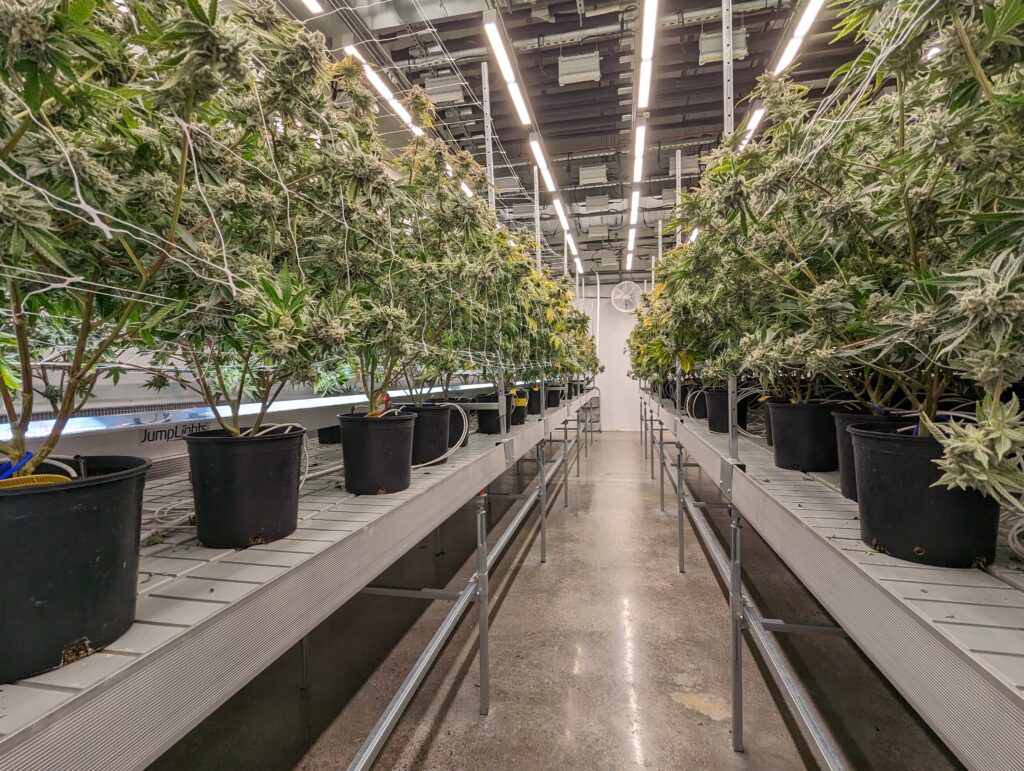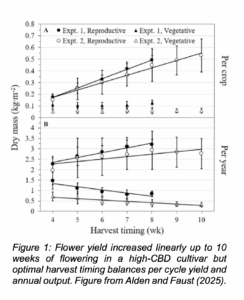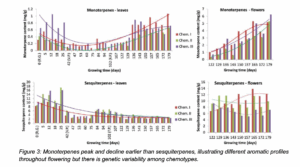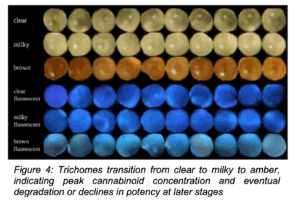
May 22, 2025
Introduction
Harvest timing directly influences cannabis yield and phytochemical profile. Until recently, growers had sparse scientific guidance and relied primarily on intuition. Now, controlled studies are elucidating how long to flower plants to optimize yield, potency, and profitability. The emerging consensus is that there is an optimal window – a “perfect moment”, if you will – to harvest. Missing this window can mean sacrificing yield, chemical quality, or worse – profits. Unfortunately, the perfect moment is not universal – it depends on the cultivar, the grower’s objectives, and even regulatory limits in the case of hemp. This review distills findings from recent research on yield progression, cannabinoid and terpene evolution, and cultivar-specific considerations, guiding growers toward the perfect moment that best aligns with their unique objectives and constraints.
Flower Yield Over Time
Most studies indicate that cannabis yield increases steadily throughout the flowering phase in indoor cultivation. In a recent study with a high-CBD cultivar, flower yield increased in roughly a linear fashion up to 10 weeks after the start of flowering (Figure 1). [1] Similarly, in a separate study, there was a linear increase in yield between week 5 and week 11 in an indoor-grown high-CBD cultivar [2]. In practical terms, allowing plants to flower longer will produce higher yields. As long as plants are green and healthy, they will continue doing photosynthesis and increasing flower mass. Beyond a certain point, however, additional yieldcomes at the cost of harvests per year. For example, Alden and Faust (2025) reported that while per cycle yield increased up to 10 weeks, the annual yield (considering multiple grow cycles per year) was maximized at 8 weeks (Figure 1). This is because shorter cycles enable more harvests per year – so there is an economic sweet spot between per cycle and per year yields.
In commercial settings, it is critical to maximize yield per year, not just per cycle, by optimizing harvest timing.[1]

Cannabinoids and Progression of Potency
In contrast to yield, cannabinoids generally do not increase indefinitely with longer flowering. In controlled experiments, the concentration of key cannabinoids (like THC and CBD) tends to rise to a maximum and then gradually decline before harvest[1, 3–5]. This decline is often attributed to over-maturity and degradation of cannabinoids (e.g. THC converting to CBN).
That said, not all studies show a reduction in potency in late flower. For example, an indoor study of a high CBD cultivar noted no significant change in total CBD concentration between weeks 5, 7, 9, and 11 of flowering[2].
Genetics play a major role in timing of peak cannabinoid production. In a comprehensive study, type-I (THC dominant) cultivars reached maximum sooner than type-III (CBD dominant) cultivars (Figure 2)[4]. This suggests growers of high-THC varieties must be careful not to overshoot the peak, whereas growers of high-CBD varieties might have a slightly broader window where potency holds before declining. Nonetheless, both types will eventually lose potency if left unharvested too long.
Terpenes and Evolution of Aroma
Terpenes – the aromatic compounds in cannabis – also change over time. Monoterpenes and sesquiterpenes increased steadily from early flowering to full flower (9 weeks after germination), then dropped by the time seeds matured[6]. Delaying harvest can lead to loss of the lighter monoterpenes responsible for fruity and piney notes as they evaporate or convert to other compounds.
Interestingly, different terpene classes may behave differently over time (Figure 3). Monoterpenes (the lighter, more volatile molecules) tend to peak and decline earlier than sesquiterpenes (heavier, spicy or woody aromas)[4].
While nutrient management is beyond the scope of this review, one study noted that a higher nitrogen supply can dilute terpene and cannabinoid concentrations[7]. This underscores that terpene evolution and optimal harvest time depends on both genetics and the environment.


Trichome Maturation as a Harvest Indicator
Cannabis glandular trichomes are the visual key many growers use to judge ripeness. Trichomes progress from clear (immature) to cloudy/milky (mature, full of cannabinoids) and finally dark amber/black (overripe). This color change has been long correlated with chemical maturity[8], and recent analytical imaging confirms it (Figure 4)[9]. Early in flower most trichome heads were transparent, but by peak maturity a majority turned opaque white, indicating maximum cannabinoid concentration, and in later stages increasing amber/brown hues and even physical collapse of some trichome heads[9].
This evidence supports the common practice of harvesting when trichomes are mostly milky with only a small percentage starting to amber. At that point, THC and other cannabinoids are generally at peak concentrations. A high fraction of amber trichomes might signal that cannabinoids are degrading.
Visual cues will never be as precise as lab tests, but they can allow growers to make on the-spot decisions about when to harvest.

Balancing Biology and Business
In commercial cannabis production, the optimal harvest timing is a balancing act shaped by the grower’s objectives and, more importantly, practical economics. If maximizing total cannabinoid yield per plant for extraction is the goal, one might extend flowering until total cannabinoid content (potency x biomass) peaks. Conversely, if top-shelf smokable flower is the goal, a slightly earlier harvest at peak potency may be preferred – at the expense of flower yield.
In practice, the optimal harvest time depends more on business than it does biology. A perpetual harvest cycle, where rooms are flowered and harvested on a fixed schedule, streamlines labor use, maintains predictable cash flow, and ensures a steady product supply. Although it may sacrifice some yield or custom timing for certain cultivars or craft consumers, the operational efficiency of consistent schedules generally offsets these trade-offs for large-scale production.
Conclusion
Harvest timing is as much an art as it is a science – not to mention the business aspect. Ultimately, harvest timing should be grounded in both scientific data and practical constraints. By carefully monitoring flower progression, cultivators can achieve high yields, potency, and profits. For large-scale producers, establishing a fixed perpetual harvest schedule often proves most profitable, striking the right balance between maximizing yield and quality, and maintaining streamlined, predictable operations.
References
- Alden, M. J. & Faust, J. E. Optimal Harvest Timing: Quantifying Temporal Changes in Dry Mass and Tissue Cannabinoids for High-CBD Cannabis sativa Grown in Controlled Environments. (2025) doi:10.21273/HORTSCI18415- 24.
- Crispim Massuela, D., Hartung, J., Munz, S., Erpenbach, F. & Graeff-Hönninger, S. Impact of Harvest Time and Pruning Technique on Total CBD Concentration and Yield of Medicinal Cannabis. Plants 11, 140 (2022).
- Yang, R. et al. Development of Cannabinoids in Flowers of Industrial Hemp (Cannabis sativa L.): A Pilot Study. J. Agric. Food Chem. 68, 6058–6064 (2020).
- Aizpurua-Olaizola, O. et al. Evolution of the Cannabinoid and Terpene Content during the Growth of Cannabis sativa Plants from Different Chemotypes. J. Nat. Prod. 79, 324–331 (2016).
- Westmoreland, F. M., Kusuma, P. & Bugbee, B. Cannabis lighting: Decreasing blue photon fraction increases yield but efficacy is more important for cost effective production of cannabinoids. PLoS ONE 16, e0248988 (2021).
- Noppawan, P. et al. Effect of harvest time on the compositional changes in essential oils, cannabinoids, and waxes of hemp (Cannabis sativa L.). Royal Society Open Science 9, 211699 (2022).
- Saloner, A. & Bernstein, N. Nitrogen supply affects cannabinoid and terpenoid profile in medical cannabis (Cannabis sativa L.). Industrial Crops and Products 167, 113516 (2021).
- Mahlberg, P. G. & Kim, E. S. Accumulation of Cannabinoids in Glandular Trichomes of Cannabis (Cannabaceae). Journal of Industrial Hemp 9, 15–36 (2004).
- Sutton, D. B., Punja, Z. K. & Hamarneh, G. Characterization of trichome phenotypes to assess maturation and flower development in Cannabis sativa L. (cannabis) by automatic trichome gland analysis. Smart Agricultural Technology 3, 100111 (2023).




